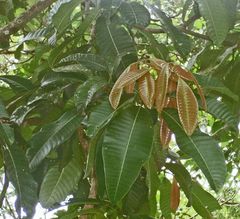Mangifera foetida
| Mangifera foetida subsp. var. | ||||||||||||||||||||||||||||||||||||||||||||||||||||||||
|---|---|---|---|---|---|---|---|---|---|---|---|---|---|---|---|---|---|---|---|---|---|---|---|---|---|---|---|---|---|---|---|---|---|---|---|---|---|---|---|---|---|---|---|---|---|---|---|---|---|---|---|---|---|---|---|---|

|
|
| ||||||||||||||||||||||||||||||||||||||||||||||||||||||
| ||||||||||||||||||||||||||||||||||||||||||||||||||||||||
Mangifera foetida (also called Horse Mango) is a species of plant in the Anacardiaceae family. It is found in SE Asia.
| Standard Cyclopedia of Horticulture |
|---|
|
Mangifera foetida, Lour. Bachang. Ambatjang. A large tree, with elliptic-oblong to obovatc lvs. 10-12 in. long, 3-4 in. broad, acute at base, acute to obtuse at apex; petiole stout, 1- 1 ½ in. long: panicle large, stout, deep red; fls. subsessile; sepals ovate, obtuse; petals linear- lanceolate, reflexed, pink or red; stamens 5, 1 perfect, the rest shorter, imperfect; ovary glabrous, oblique, green, smooth, very fetid; flesh yellow, stone very fibrous. Distributed throughout the Malay Archipelago, where the fr. is eaten by the natives but is considered of very poor quality by Europeans.
|
Cultivation
Propagation
Pests and diseases
Varieties
Gallery
-
photo 1
-
photo 2
-
photo 3
References
- Standard Cyclopedia of Horticulture, by L. H. Bailey, MacMillan Co., 1963
External links
- w:Mangifera foetida. Some of the material on this page may be from Wikipedia, under the Creative Commons license.
- Mangifera foetida QR Code (Size 50, 100, 200, 500)
